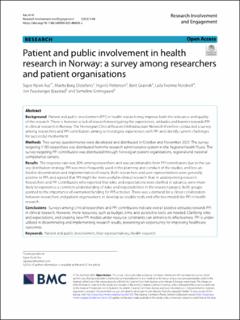| dc.contributor.author | Aas, Sigve Nyvik | |
| dc.contributor.author | Distefano, Marita Borg | |
| dc.contributor.author | Pettersen, Ingvild | |
| dc.contributor.author | Gravrok, Berit | |
| dc.contributor.author | Nordvoll, Laila Yvonne | |
| dc.contributor.author | Fausanger, Jon | |
| dc.contributor.author | Grimsgaard, Sameline | |
| dc.date.accessioned | 2024-03-05T15:10:07Z | |
| dc.date.available | 2024-03-05T15:10:07Z | |
| dc.date.created | 2023-09-05T10:11:44Z | |
| dc.date.issued | 2023 | |
| dc.identifier.citation | Research Involvement and Engagement. 2023, 9, 48. | en_US |
| dc.identifier.issn | 2056-7529 | |
| dc.identifier.uri | https://hdl.handle.net/11250/3121150 | |
| dc.description.abstract | Background - Patient and public involvement (PPI) in health research may improve both the relevance and quality of the research. There is however a lack of research investigating the experiences, attitudes and barriers towards PPI in clinical research in Norway. The Norwegian Clinical Research Infrastructure Network therefore conducted a survey among researchers and PPI contributors aiming to investigate experiences with PPI and identify current challenges for successful involvement.
Methods - Two survey questionnaires were developed and distributed in October and November 2021. The survey targeting 1185 researchers was distributed from the research administrative system in the Regional Health Trusts. The survey targeting PPI contributors was distributed through Norwegian patient organisations, regional and national competence centers.
Results - The response rate was 30% among researchers and was unobtainable from PPI contributors due to the survey distribution strategy. PPI was most frequently used in the planning and conduct of the studies, and less utilized in dissemination and implementation of results. Both researchers and user representatives were generally positive to PPI, and agreed that PPI might be more useful in clinical research than in underpinning research. Researchers and PPI contributors who reported that roles and expectations were clarified in advance, were more likely to experience a common understanding of roles and responsibilities in the research project. Both groups pointed to the importance of earmarked funding for PPI activities. There was a demand for a closer collaboration between researchers and patient organisations to develop accessible tools and effective models for PPI in health research.
Conclusions - Surveys among clinical researchers and PPI contributors indicate overall positive attitudes towards PPI in clinical research. However, more resources, such as budget, time, and accessible tools, are needed. Clarifying roles and expectations, and creating new PPI models under resource constraints can enhance its effectiveness. PPI is underutilized in disseminating and implementing research results, presenting an opportunity for improving healthcare outcomes. | en_US |
| dc.language.iso | eng | en_US |
| dc.publisher | BioMed Central (BMC) | en_US |
| dc.rights | Navngivelse 4.0 Internasjonal | * |
| dc.rights.uri | http://creativecommons.org/licenses/by/4.0/deed.no | * |
| dc.title | Patient and public involvement in health research in Norway: a survey among researchers and patient organisations | en_US |
| dc.title.alternative | Patient and public involvement in health research in Norway: a survey among researchers and patient organisations | en_US |
| dc.type | Peer reviewed | en_US |
| dc.type | Journal article | en_US |
| dc.description.version | publishedVersion | en_US |
| dc.source.pagenumber | 8 | en_US |
| dc.source.volume | 9 | en_US |
| dc.source.journal | Research Involvement and Engagement | en_US |
| dc.source.issue | 1 | en_US |
| dc.identifier.doi | 10.1186/s40900-023-00458-x | |
| dc.identifier.cristin | 2172380 | |
| cristin.ispublished | true | |
| cristin.fulltext | original | |
| cristin.qualitycode | 1 | |

